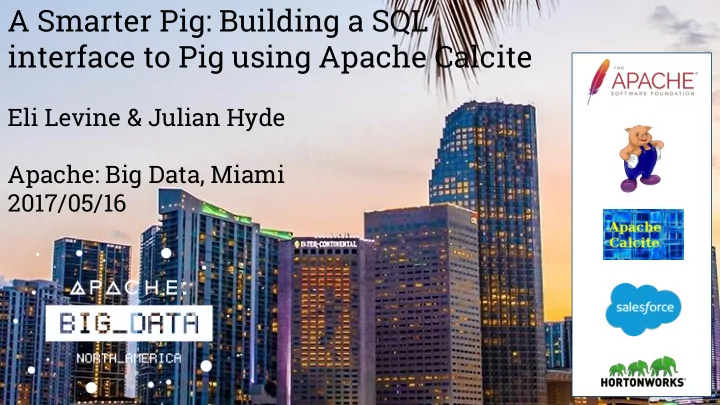

A Smarter Pig: Building a SQL interface to Pig using Apache Calcite Eli Levine & Julian Hyde Apache: Big Data, Miami 2017/05/16
About us Eli Levine @teleturn PMC member of Phoenix ASF member Julian Hyde @julianhyde Original developer of Calcite PMC member of Calcite, Drill, Eagle, Kylin ASF member
Apache Calcite Apache top-level project since October, 2015 Query planning framework Relational algebra, rewrite rules ➢ Cost model & statistics ➢ Federation via adapters ➢ Extensible ➢ Packaging Library ➢ Optional SQL parser, JDBC server ➢ Community-authored rules, adapters ➢
Apache Pig Apache top-level project Platform for Analyzing Large Datasets Uses Pig Latin language ➢ ○ Relational operators (join, filter) ○ Functional operators (map, reduce) Runs as MapReduce (also Tez) ➢ ETL ➢ Extensible ➢ ○ LOAD/STORE UDFs ○
Outline Batch compute on Force.com Platform (Eli Levine) Apache Calcite deep dive (Julian Hyde) Building Pig adapter for Calcite (Eli Levine) Q&A
Salesforce Platform Object-relational data model in the cloud Contains standard objects that users can customize or add their own SQL-like query language SOQL SELECT DEPT.NAME - Real-time FROM EMPLOYEE - Batch/ETL WHERE FIRST_NAME = ‘Eli’ Federated data store: Oracle, HBase, external User queries span data sources (federated joins)
Salesforce Platform - Current Batch/ETL Called Async SOQL - REST API - Users supply SOQL and info about where to deposit results SOQL -> Pig Latin script Pig loaders move data/computation to HDFS for federated query execution Own SOQL parsing, no Calcite
Query Planning in Async SOQL Current Next generation
Apache Calcite for Next-Gen Optimizer - Strong relational algebra foundation - Support for different physical engines - Pluggable cost model - Optimization rules - Federation-aware
[Julian talks about Calcite] - Building blocks for building query engine or DB - Federation-aware - Represent and optimize logical plan - Convert to physical plan
select p.productName, count (*) as c Planning queries from splunk.splunk as s join mysql.products as p on s.productId = p.productId where s.action = 'purchase' group by p.productName order by c desc Splunk Table: splunk Key: productId Key: productName Key: c desc Condition: Agg: count action = 'purchase' scan join MySQL filter group sort scan Table: products
select p.productName, count (*) as c Optimized query from splunk.splunk as s join mysql.products as p on s.productId = p.productId where s.action = 'purchase' group by p.productName order by c desc Splunk Table: splunk Condition: action = 'purchase' Key: productName Key: productId Key: c desc Agg: count scan filter MySQL join group sort scan Table: products
Adapters Connect to a data source How to push down logic to the data source? A set of planner rules Maybe also a calling convention Maybe also a query model & query generator
Calcite Pig Adapter SELECT DEPT_ID FROM EMPLOYEE GROUP BY DEPT_ID HAVING COUNT(DEPT_ID) > 10 EMPLOYEE = LOAD 'EMPLOYEE' ... ; EMPLOYEE = GROUP EMPLOYEE BY (DEPT_ID); EMPLOYEE = FOREACH EMPLOYEE GENERATE COUNT (EMPLOYEE.DEPT_ID) as DEPT_ID__COUNT_, group as DEPT_ID; EMPLOYEE = FILTER EMPLOYEE BY (DEPT_ID__COUNT_ > 10);
Building the Pig Adapter 1. Implement Pig-specific RelNodes. e.g. PigFilter 2. RelNode Factories 3. Various RelOptRule types for converting Abstract RelNodes to PigRelNodes 4. Schema implementation (several iterations) 5. Unit tests run local Pig
Lessons Learned Calcite is very flexible (both good and bad) Lots available out of the box Little info on writing optimization and conversion rules Dynamic code generation using Janino -- cryptic errors SQL maps well to Pig. Inverse not always true.
Thank you! Eli Levine @teleturn Julian Hyde @julianhyde http://calcite.apache.org http://pig.apache.org
Recommend
More recommend